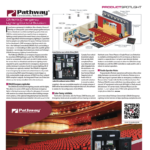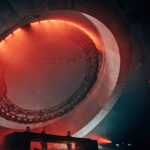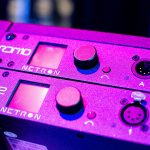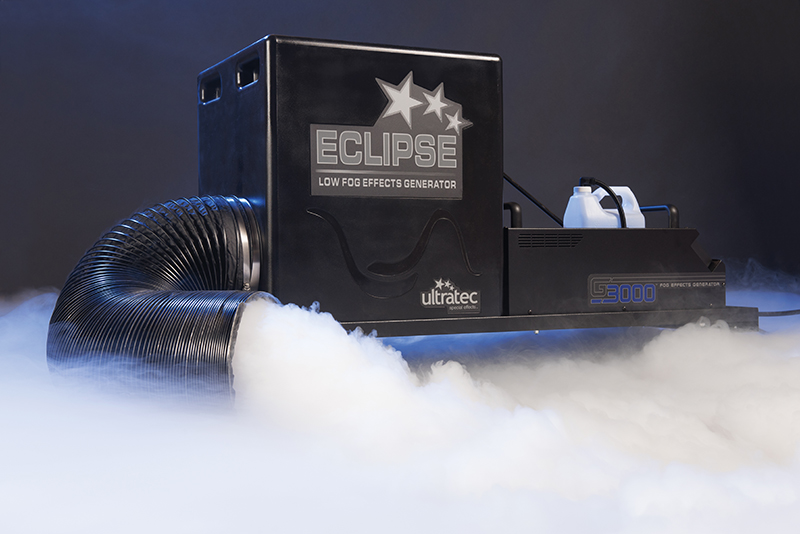
While walking the floor at the NAMM show in January, I stopped by an interesting booth that had a wind tunnel full of confetti blasting away and a large assortment of atmospheric engineering devices (smoke and fog machines) hazing up the joint. Ultratec Special Effects and Grand Majestic FX were showing their wares to many passersby.
While checking out the wide variety of gear on display, I happened to look down and notice I could not see anything below my knees. The ground was hidden in a condensed fog that shielded the area, including the device responsible for outputting this rolling fog throughout the booth.
I immediately looked around for a large metal box with an industrial hose spouting out, like one would normally see containing a low fog effects machine. It’s not evident. As the fog dissipates, I find the culprit. It’s simply the well-known G3000 machine, but now the unit is spitting its smoke output directly into a small box titled the Eclipse Low Fog Effects Generator, which spills the fog on to the floor through a 10-inch industrial dryer-type hose.
From the 1980s to Today
Low fog effects have been around since some technicians figured out how to attach a 3,500-watt heating element to a 55-gallon drum to heat water, then dropped dry ice directly into it. With a hole on the side attached to an extended dryer hose, cold fog rushed out of the drum and lay close to the ground. Eighties-era rock bands wallowed in this effect. To this day, all sorts of versions of this device have been developed with similar technology, but they all had common issues — they were single-use machines and they took up a lot of stage space. There was a fair amount of heat time needed to get the water to a high temperature. Plus, the effect dissipated within a couple minutes once the ice turned to gas — it wasn’t continuous. And ridding the stage of the used water after the show was never simple.
With time came more LSG machines (Low Smoke Generators) made from mixing specific fog fluids and cooling via CO2 directly to form a fog that laid low, but lasted longer. Ultratec, who has been around more than 25 years themselves, has been doing R&D on this line of fog generation for years. But now, they have taken the art of LSG to the next level by offering a stealthy and sturdy box that is less than two feet in height and can ride in a cart. They have done away with the need for a large container that occupied way too much stage space.
“It’s a small chilling box that we have devised to work in conjunction with our G3000 unit,” explains Tony Wikner, a senior service technician with Ultratec FX. “The case itself is smaller than two foot square and can easily be moved around by the carrying handle slots in the top. We feed CO2 directly into the unit with a standard Dual Quick Detachable Valve. The CO2 line can be switched open via a single DMX channel. Inside we have a variable fan for pushing the fog out at different speeds. The second DMX channel to the Eclipse activates the fan.” He goes on to show me that the speed of the fan is manually set on the top backside of the unit. This allows the user to preset how fast and far the production needs the fog to travel for each particular effect.
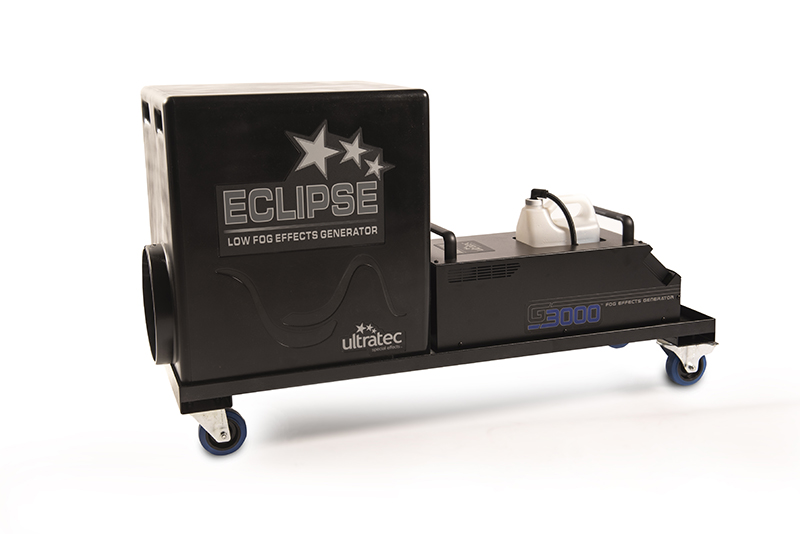
Fog Fluid Choices
Wikner expands on what else is necessary. “At Ultratec, we now make 14 different types of fluids for all the various machines we manufacture as well as the type of fog one is looking for. We have come up with our 4L Molecular fluid, designed specifically for our products, to keep the fog at a low level and quickly dissipate as it rises. The fog emitted is typically heavier than traditional smoke machines and will actually fall to the ground from an elevated state. Shows have used this effect as a fog waterfall.” These manufacturers of theatrical fog fluid have developed specially formulated mixtures specifically designed to be chilled with CO2, intended to provide thicker, more consistent fog effects. It is a water-base fog fluid.
To feed the smoke into the Eclipse for chilling, Ultratec is using one of their standard G3000 smoke machines, a staple on thousands of live events and installations around the world. This unit is designed for fast bursts as well as continuous running of fog output. This machine boasts a 2,000W Dual Core Rapid Change Block that requires 12 minutes to preheat. The unit can detect low fluid levels and offers continuous thermal control. The fixture can run off DMX and also has a full functional back lit digital remote. The beauty of the G3000 is its compatibility with the Eclipse and its ability to use the LSG (Molecular) fluid.
With the cart scenario, we have a regular black air hose that runs from a CO2 tank hidden somewhere, to the Eclipse. The G3000 sits on the open-faced cart (think of a dolly) with its spout nestled right up to the input of the Eclipse. Adjustable straps hold the units in place. The G3000 has an auxiliary DMX connector that can be used to daisy chain the control signal to the Eclipse. Both of these machines are running on 110V via PowerCon connections here, but Ultratec offers 220V models as well.
On the output side of the Eclipse is a positive locking 10-inch flange. It attaches to a quick lock hose adapter, which fits on a heavy-duty black rubber industrial hose. Ultratec has mounted a fan intake on the back of the Eclipse. As for the hose, Wikner explains that 25-foot lengths are the norm that most people need for long lengths. “But we opted for one powerful single fan with 600 cubic feet per minute (CFM) of force as opposed to two 200 CFM fans to give it that quick hard push. With this unit, we have seen 50-foot hoses in operation.” I do note that the fog being emitted is pure white in color and will accept light beautifully.
We inquired if the G3000 unit could be detached from the Eclipse and still work as an ordinary fogger with the Molecular fog fluid. Tony replied, “Molecular fluid works fine as a fog fluid but was formulated to bring out the best results in a low lying fog application such as the Eclipse. So yes, the G3000 will work for your basic fog needs with this fluid standing alone, but we offer superior fluids better suited for the full stage fog effect.”
Physically, the Eclipse has a shell made of a one-piece, ¼-inch-thick polymer plastic, designed for road use. Controls for the fan speed, AC Input, fan and intake slot from the G3000 are all located on the back panel made of stainless steel. It also serves as the rear access panel should one wish to get inside to service (clean). On the back bottom is a stainless steel drain valve for getting rid of any residual fluids that have built up inside the Eclipse during operation.
The Eclipse weighs a mere 47 pounds and can ride in its own road case. It can also ride in a cart or road case with either the G3000 or the industrial PFI 9D Fog Machine, also developed by Ultratec (ultratecfx.com). Size-wise, it takes up 22.5 by 19 inches and measures 22 inches in height. It draws one amp of power at 110V, meaning the Eclipse combined with the G3000 can run on one 20A outlet.
At a Glance:
A Compact LFG Powerhouse
The Eclipse LFG system is compact and built sturdy, perfect for remote film locations as well as concert tours and theatrical plays. It promises more output than many alternate low fog effects devices, with less real estate taken up.
PROS: Compact size. Ease of setup, especially when the cart is included. Great Quick Lock mechanism for output hose. Strong industrial style fan.
CONS: Could use a self-adjusting power supply for any voltage input.
Ultratec Eclipse LFG System
SPECS
- Input Voltage: 110V or 220V
- Fan Speed: Manually adjusted
- Fan Power: 600 CFU
- Power Draw: 1 amp
- Control: Two DMX channels
- Valve for CO2: Dual; Quick Detachable
- Eclipse Size: 22.5 x 19 x 23” (LxWxH)
- Eclipse Weight: 47 lbs.
- Size w/Cart: 36 x 48 x 30” (LxWxH)
- CO2 Usage: 7.5 lbs./min. (high/low pressure); 15 lbs./min. (high power)
- MSRP: $4,147.50 (Eclipse)*; $8,542.80 (Eclipse + G3000 + Road Case)*; $7,844.55 (Eclipse + G3000 + cart)*
- Manufacturer: Ultratec Special FX
- More Info: ultratecfx.com
*(CO2 tank and hose not included)
